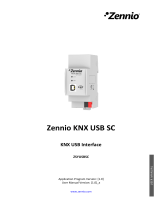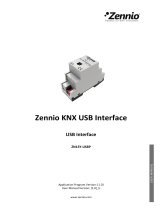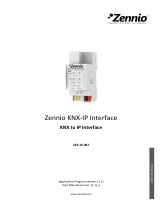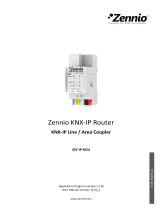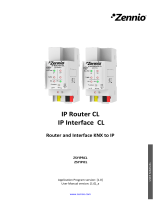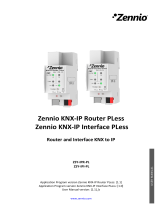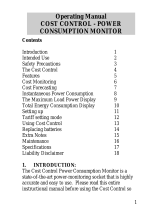Page is loading ...

Zennio KCI 4 S0
http://www.zennio.com Technical Support: http://support.zennio.com
2
CONTENTS
Contents ........................................................................................................................................ 2
Document Updates ....................................................................................................................... 3
1 Introduction .......................................................................................................................... 4
1.1 KCI 4 S0 .......................................................................................................................... 4
1.2 Installation ..................................................................................................................... 5
1.3 Consumption Data Resets after a Download ................................................................ 7
1.4 Setting the Time of Day ................................................................................................. 7
2 Configuration......................................................................................................................... 8
2.1 General .......................................................................................................................... 8
2.2 Input S0x ...................................................................................................................... 11
2.2.1 Configuration ....................................................................................................... 11
2.2.2 Total Register ....................................................................................................... 13
2.2.3 Partial Registers ................................................................................................... 17
2.2.4 Electric Power (or Water/Gas Flow) .................................................................... 18
2.2.5 Tariff ..................................................................................................................... 22
2.2.6 Notifications ......................................................................................................... 23
2.2.7 Alarms .................................................................................................................. 25
2.3 Initialisation and Power Loss ....................................................................................... 29
2.4 Logic Functions ............................................................................................................ 31
ANNEX I: Power Calculation ........................................................................................................ 32
ANNEX II. Communication Objects.............................................................................................. 35

Zennio KCI 4 S0
http://www.zennio.com Technical Support: http://support.zennio.com
3
DOCUMENT UPDATES
Version Changes Page(s)
[2.0]_a
Changes in the application program:
• Date and time-of-day objects.
• Additional consumption registers (one total
register plus three partial registers).
• Per-register calculation of cost and equivalent
CO2 emissions.
• Per-tariff consumption calculation.
• Periodical reset of partial registers.
• Water/gas flow, electric power and pulse
monitoring alarms.
• Notifications upon exceedance of specific
consumption values.
• Inputs lock and register reading on request.
• Ten logic functions.
• Possibility of maintaining the previous
consumption registers after download.
-
Major revision of the whole document due to the new
functionality.
-
[1.1]_a
Changes in the application program:
• Optimisation of the S0-pulse count algorithm.
-

Zennio KCI 4 S0
http://www.zennio.com Technical Support: http://support.zennio.com
4
1 INTRODUCTION
1.1 KCI 4 S0
KCI 4 S0 from Zennio is an S0 to KNX interface that makes it possible to integrate S0-
pulse generators into the KNX installation. Specifically, up to four S0-pulse
generators can be connected independently to the inputs of KCI 4 S0, which will
interpret these S0 pulses as energy, water or gas consumption measurements,
depending on the external S0-compliant meter that has been connected.
Therefore, KCI 4 S0 brings the possibility of notifying other KNX devices about the
consumption levels measured by external S0-pulse generators. In practice, KCI may
still manage flows or volumes of any other type (not only electric power, water and gas)
as long as they are measured by a pulse generator (even non-S0 pulses can be
recognised). However this is not guaranteed – previous testing is encouraged.
The most outstanding features of KCI 4 S0 are:
4x inputs for monitoring up to four S0-pulse generators.
Possibility of disabling each input independently.
Up to four registers per input (one total and three partial).
Customisable pulse frequency, i.e., possibility of setting how many pulses
are expected per unit consumption.
Possibility of sending the energy, water or gas consumption values to the
KNX bus both periodically or on value changes.
Calculation of the electric power and of the water/gas flow rate, with the
possibility of sending them to the KNX bus both periodically or on value
changes.
Alarms for power / flow excess and low power / flow.
Per-tariff calculation of cost and CO2 equivalent emissions, for up to two
registers per input.

Zennio KCI 4 S0
http://www.zennio.com Technical Support: http://support.zennio.com
5
Calculation of cost and CO2 equivalent emissions for each register.
Pulse and consumption monitoring alarms.
Objects to request the accumulated consumption values.
Possibility of customising the initial consumption value and of maintaining
the accumulated consumption after a download.
Auxiliary battery pack to ensure the pulse count even in the absence of bus
power.
LEDs and communication objects to indicate low or empty battery.
10 customisable, multi-operation logic functions.
1.2 INSTALLATION
KCI 4 S0 connects to the KNX bus through the on-board KNX connector. Once the
device is provided with power from the KNX bus, both the individual address and the
associated application program can be downloaded.
Figure 1: KCI 4 S0 - Element Diagram.
The main elements of the device are described next.
1
2
3
4
5
6
7
8
1. Battery Holder.
2. EMPTY Battery LED Indicator.
3. LOW Battery LED Indicator.
4. Prog./Test Button.
5. Prog./Test LED.
6. Input Indicator LED.
7. Input Connectors.
8. KNX Connector.

Zennio KCI 4 S0
http://www.zennio.com Technical Support: http://support.zennio.com
6
Test/Prog. Pushbutton (4): a short press on this button sets the device into
the programming mode, making the associated LED (5) light in red.
Note: if this button is held while plugging the device into the KNX bus, the
device will enter into safe mode. In such case, the LED will blink in red.
Input Connectors (7): slots for the connection of the input lines from the
pulse generators. Whenever a pulse is received through one of the inputs, the
associated LED (6) will flash briefly.
Battery Holder (1): host for the two CR2032 batteries (2 x 3V) that will
provide power in the absence of the KNX bus.
Low-Battery Indicator (3): LED indicator that will blink in red if the battery
level is weak. It is advisable to change the batteries when this happens.
Empty-Battery Indicator (2): LED indicator that will blink in red if the battery
level is critically low. It is required to change the batteries when this happens.
Notes regarding the low/empty battery indicators:
The two LED indicators are mutually exclusive. Once the empty-battery
indicator turns on, the low-battery indicator will turn off.
In the absence of KNX bus power, the device will keep trying to count pulses
even in the empty-battery state. However, once under the low-battery level,
an accurate behaviour cannot be guaranteed.
To extend the battery life, the empty/low battery indicators only blink in
presence of KNX bus power. In other words, it is once the bus recovers
from the power failure that KCI 4 S0 will resume the battery level check.
To get detailed information about the technical features of the device, as well as on the
installation and security procedures, please refer to the corresponding Datasheet,
bundled with the original package of the device and also available at www.zennio.com.

Zennio KCI 4 S0
http://www.zennio.com Technical Support: http://support.zennio.com
7
1.3 CONSUMPTION DATA RESETS AFTER A DOWNLOAD
It is important to bear in mind that, by default, reprogramming the device from ETS
(through either partial or complete downloads) clears the consumption variables and
therefore any data accumulated so far on both partial and total registers (see sections
2.2.2 and 2.2.3).
Should these values need to be resumed after reprograming the device, the integrator
should activate in ETS, prior to the download, the option to maintain the current value
of such registers, or alternatively set an initial value for the energy or volume.
1.4 SETTING THE TIME OF DAY
To make use of calendar-dependent functions, such as periodical registers or the
register initial dates, an external clock (such as the one in Z41 from Zennio) should be
present in the installation in order to synchronise the KCI internal clock.
To that end, KCI will request the time of day during the start-up. Up to four read
requests will be sent (after a customisable, initial delay) to the KNX bus. Specific date
and time of day objects are provided for this.
Notes:
The time count is performed internally by KCI. However, it must be notified
(through external events) about any time adjustments in order to ensure the
synchronisation of the periodical timing of the registers .
It is advisable to resynchronise the internal time count periodically to prevent
precision loss after prolonged operation. Therefore, KCI sends a time request
to the KNX bus every 15 minutes.

Zennio KCI 4 S0
http://www.zennio.com Technical Support: http://support.zennio.com
8
2 CONFIGURATION
2.1 GENERAL
KCI 4 S0 incorporates four input channels for connecting up to four S0-pulse
generators. Which ones will be in use is the first thing to configure.
On the other hand, two one-bit alarm objects will be available in the project by default,
besides of Date and Time of Day objects (see section 1.4). Their behaviour will be
analogous to that of the on-board LED indicators that inform, respectively, about low
battery and empty battery. While any of these LEDs remains on, the corresponding
object will be sent to the bus with the value “1” every 15 minutes. Once the alarm
situation is over, the LED turns off and the object is sent once with the value “0”.
Please, refer to section 1.2 for more details about the battery warnings.
Besides, additional objects can be enabled to request global consumption data or to
lock the inputs.
Finally, ten customisable, multi-operation logic functions can be enabled too.
ETS PARAMETERISATION
After importing the corresponding database in ETS and adding the device into the
topology of the desired project, the configuration process begins by right-clicking into
the device and selecting Edit parameters.
The “General” parameter screen is the only shown by default.

Zennio KCI 4 S0
http://www.zennio.com Technical Support: http://support.zennio.com
9
Figure 2: General.
Four checkboxes (one per input channel) let the integrator select which input channels
will be in use. Additional entries will be included in the tab menu on the left depending
on the number of active inputs.
The options for each of the inputs are detailed in the next sections.
Besides, additional parameters are available to enable or disable the following
communication objects:
Object for Global Data Request: enables the “Global Data Request” one-
bit object, which can be sent the value “1” to request the global consumption
values from all the input channels.
Object for Global Disable: enables the “Global Disable” one-bit object,
which by default has the value “1”. When it receives the value “0”, KCI
interrupts all actions, including the pulse count in all inputs. Only data
requests will be responded.
Initial Delay: time between 1 and 255 seconds the device will wait after the
start-up before sending the date and time requests (see section 1.4).
Logic Functions: enables the Logic Functions configuration screen (see
section 2.4).
On the other hand, the following objects are available in the project topology at any
time:

Zennio KCI 4 S0
http://www.zennio.com Technical Support: http://support.zennio.com
10
“Date”: its value will become periodically updated according to the internal
date of the device. It can also receive values from an external clock for
synchronisation purposes.
“Time of Day”: its value will become periodically updated according to the
internal time of the device. It can also receive values from an external clock
for synchronisation purposes.
“Alarm: Low Battery”: one-bit object that will send a “1” every 15 minutes if
the battery level is low, and a “0” (only once) if this no longer happens. This
object is analogous to the low-battery LED indicator.
“Alarm: Empty Battery”: one-bit object that will send a “1” every 15 minutes
if the battery level is critically low (or zero), and a “0” (only once) if this no
longer happens. This object is analogous to the empty-battery LED indicator.
As with the LED indicators, the two alarm objects are mutually exclusive. Once the
level of the battery becomes empty, KCI 4 S0 will start sending the empty-battery
object and will stop sending the low-battery object (which will be then sent with the
value “0” –only once–).
Figure 3: Battery Alarms
t
1
t
2
Battery
Time
t
1
: Low-battery alarm activation.
t
2
: Low-battery alarm deactivation +
Empty-battery alarm activation.

Zennio KCI 4 S0
http://www.zennio.com Technical Support: http://support.zennio.com
11
2.2 INPUT S0x
2.2.1 CONFIGURATION
Each input channel of KCI 4 S0 can be particularised for two different scenarios,
depending on the type of the S0-pulse generator connected to it:
Electrical energy consumption meters.
Water or gas volume consumption meters.
The options available will slightly differ for each case, although are entirely analogous.
Even though the compatibility is not guaranteed, KCI 4 S0 should also recognise
pulses of any other kind (even non-S0); however, previous testing is highly advisable.
As electric power, water or gas are being consumed, the pulse generator will send
pulses to KCI 4 S0. To interpret the pulses, KCI 4 S0 needs to know the pulse
frequency, which is the ratio (provided by the manufacturer) between the number of
pulses sent by the external meter and the amount of electrical energy (or water or gas)
measured, i.e., the number of pulses sent per unit energy (or per unit volume). The
higher the pulse frequency, the lower the consumption increases assumed by KCI 4 S0
on the reception of each pulse.
For each S0 input, it is possible to enable a total register, up to three partial
registers and the calculation of the electric power or water/gas flow. The main
difference between total and a partial register is the latter one can be reset periodically
or through object (see section 2.2.3). Therefore, both the total consumption since the
start-up and the partial consumption during several time intervals will be available. The
energy/volume units of measurement can be selected independently for each register
in order to allow more resolution when required. The options are: watt-hours (Wh),
kilowatt-hours (kWh), litres (l) or cubic metres (m
3
), depending on the meter type.
On the other hand, KCI can also calculate:
The kilogrammes of carbon dioxide that have been released to the
atmosphere to obtain the energy consumed. To that end, it is necessary to
set the CO2 ratio, i.e., the CO2 kilogrammes per kWh (or m
3
) consumed.

Zennio KCI 4 S0
http://www.zennio.com Technical Support: http://support.zennio.com
12
The cost of the consumed energy, according to a certain tariff.
Consumption notifications are available for each register, together with power and
flow alarms (provided that the calculation of the power and flow has been enabled) as
well as pulse monitoring alarms.
A binary communication object to request the consumption data of such input will be
available any time, as well as a binary object to disable the input. While an input
remains disabled, it will interrupt the pulse count and will not send any objects unless
requested through the aforementioned, specific request object.
ETS PARAMETERISATION
For every active input, ETS shows one primary tab, containing another one named
Configuration with the following parameters:
Figure 4: Input S0x – Configuration.
Type of Meter: “Electricity” (default option) or “Water or gas”, depending on
what the S0-pulse generator will be measuring.
Depending on the meter type, the following parameters will refer to energy or
water/gas, although they are analogous in both cases:

Zennio KCI 4 S0
http://www.zennio.com Technical Support: http://support.zennio.com
13
Pulses per Unit Energy (or volume): sets the pulse frequency, in pulses per
kilowatt-hour (pulse/kWh) or pulses per cubic metre (pulse/m3). The available
range is 1 to 65535 (the default is “1000”).
CO2 Ratio: sets the hundredths of a kilogramme of CO2 released to the
atmosphere per unit consumption (0.01 kgCO2/kWh or 0.01 kgCO2/m
3
). The
available range is 1 to 255 (the default is “50”).
Total Register: checkbox to show or hide the total register tab (see
section 2.2.2).
Number of Partial Registers: sets the number of partial registers (up to
three) required for this specific input. There will be as many additional
parameter tabs as registers. See section 2.2.3.
Electric power (or water/gas flow): activates or deactivates the calculation
of the electric power or the gas/water flow, depending on the meter type, as
well as their configuration tabs. See section 2.2.4.
Tariff: shows or hides the Tariff tab. See section 2.2.5.
Notifications: shows or hides the Notification tab. See section 2.2.6.
Alarms: shows or hides the Alarms tab. See section 2.2.7.
Object for Input Data Request: shows or hides the “[S0x] Input Data
Request” object. If KCI receives this object with value ‘1’, it will send the KNX
bus the consumption, cost and CO2 objects of the registers corresponding to
this input.
Object for Input Disable: shows or hides the “[S0x] Input Disable” object,
which disables the current input when the value ‘0’ is received through this
object. Normal operation will be resumed as soon as the value ‘1’ is received.
2.2.2 TOTAL REGISTER
The total register stores the value of the global consumption of either energy
consumption or water/gas volume (depending on the selected meter type) together with

Zennio KCI 4 S0
http://www.zennio.com Technical Support: http://support.zennio.com
14
the value of the corresponding cost and CO2 emissions. Therefore, it reflects the per-
input values accumulated since the device start-up.
The initial value of the register can be set in parameters, being either a fixed value
(such as ‘0’) or the last value that may have already been saved in the register prior to
the download. After the first download, the previous value will be considered as ‘0’.
It is also possible to overwrite the current value of the total register anytime through a
specific object, to reset it or to set it to a specific value.
The current values of the total register can be sent to the KNX bus as follows:
Cyclically: after a certain time (configurable).
Note: the value sent by KCI 4 S0 is not an exact instant value, but the best
known value so far. Depending on the pulse frequency, there may be a
certain delay between the value being measured by the external meter and
that corresponding to the last pulse.
On value change: the current value will be sent to the bus as soon as it is
found to differ from the last sent by more than a certain amount
(configurable). On the arrival of a pulse, the device will verify if the difference
between the new value and the last sent is greater than the configured
threshold; if it is, it will notify the KNX bus. It is also possible to set a minimum
time between sendings, to avoid massive transmissions in case of high
consumption.
Cyclical and on value change: a combination of the above two options. The
current value will be sent periodically, and also when it is found to differ from
the last one sent by more than the specified amount. Note that the cyclical
sending will be also conditioned by the minimum time between sendings (if
configured), so that after a sending due to a value change there will not be
cyclical sendings until the minimum time expires.
ETS PARAMETERISATION
The parameters shown in the Total Register tab are the following:

Zennio KCI 4 S0
http://www.zennio.com Technical Support: http://support.zennio.com
15
Figure 5: Input S0x - Total Register
Energy (or Volume) Units: sets units of measurement of the total register for
either energy (“Wh” or “kWh”) or volume (litres or cubic metres).
Initial Consumption: sets the initial state of the total register after an ETS
download: “Keep Current Value” or “Set Value”. By selecting the latter, an
additional textbox will show to enter the desired value, in terms of the
selected units of measurement.
Object to Set the Energy (or Volume) Value: enables the “[S0x] [TR] Set
Consumption” four-byte object, which permits overwriting the current value
of the total register, in terms of the configured units of measurement.
Additional Objects: allows enabling four additional functions related to the
consumption register:
Figure 6: Total Register - Additional Objects CAMBIAR
Cost (only available if Tariff has been activated in the Configuration tab
corresponding to the current input; see section 2.2.1): enables the “[S01]
[TR] Cost” two-byte object, which can be read to obtain the cost
corresponding to the total consumption currently registered.

Zennio KCI 4 S0
http://www.zennio.com Technical Support: http://support.zennio.com
16
CO2 Equivalent Emissions: enables the “[S01] [TR] CO2” two-byte
object, which can be read to obtain the kilogrammes of CO2 corresponding
to the total consumption currently registered.
Consumption in each Tariff (only available if Tariff has been activated in
the Configuration tab corresponding to the current input; see section
2.2.1): enables the “[S01] [TR] Consumption in Tariff x” and “[S01] [TR]
Cost in Tariff x” objects, which can be read to obtain how much of the
accumulated consumption and cost corresponds to tariff “x”.
Note: this feature is available for up to two registers per input.
Sending Mode: sets whether the “[S0x] [TR] Consumption” object, together
with the above additional objects, should be sent automatically to the bus.
The options are: “Disabled”, “Cyclical”, “On Value Change” or “Cyclical and
on Value Change”. Depending on this selection, there more parameters will
be available:
Figure 7: Total Register - Sending modes
Period: sets the period for the periodical sendings.
Minimum Time between Sendings: sets a minimum period of time
between consecutive sendings.
Minimum Change to Send: sets the minimum change required between
two consecutive sendings.

Zennio KCI 4 S0
http://www.zennio.com Technical Support: http://support.zennio.com
17
2.2.3 PARTIAL REGISTERS
Up to three partial registers are also available per input, which will monitor consumption
during different periods of time. As the total register, they can record consumption data
itself, as well as other variables such as CO2 and cost.
In this case, setting the value of the register through an object is not possible.
Nevertheless, the parameters involved are analogous to those in the total register (see
section 2.2.2). In addition, a periodic reset can be configured with a periodicity of days
or months. An object is also available to perform a reset anytime.
Together with the objects that contain the consumption, CO2 and cost values
accumulated so far, an additional set of objects will be provided containing the values
of the immediately previous period. Therefore, every time the configured periodicity
expires and the register is reset, these objects will be sent to the bus to inform about
the final values accumulated in that period. Note that this sending will take place even if
the resending restrictions that may have been configured are not met.
ETS PARAMETERISATION
The parameters to configure any of the partial registers are:
Figure 8: Partial Register

Zennio KCI 4 S0
http://www.zennio.com Technical Support: http://support.zennio.com
18
Energy Units, Initial Consumption, Additional Objects and Sending
Mode, as well as the objects involved, are all of them similar to the analogous
parameters in the total register (section 2.2.2).
Periodic Reset: activates or deactivates the automatic reset of the partial
register whenever a certain period expires:
Period: from 1 (default) to 255 days or months.
Day of reset: in case the above period has been set in terms of months,
sets whether the reset should take place on the first day of the month
(default option) or always on the same day of the month, taking into
account the day the device starts working.
The register can also be reset upon request by sending the value “1” to the
“[S01] [PRy] Reset” binary object.
Please bear in mind the following:
In the absence of bus power at the end of the cycle, the register will be
reset upon power recovery..
In case of time adjustments, the resets may be affected by a delay.
In case of selecting “Same Day of Month”, the specific day of the month
will change whenever the register is manually reset through the object.
2.2.4 ELECTRIC POWER (OR WATER/GAS FLOW)
Based on the accumulated energy consumption and the time lapse between the
successive increments, KCI 4 S0 can obtain (and send to the KNX bus) the
corresponding electric power, in terms of watts or kilowatts, or the corresponding
water/gas flow, in terms of litres per hour (l/h) or cubic metres per second (m
3
/s).
The power and water/gas flow will be sent to the bus through two different objects, one
in watts (or litres per hour), and the other one in kilowatts (or cubic metres per second).
The integrator can select one out of two alternative methods to calculate the electric
power and the flow, named as “instantaneous value” and “average value”. How each
of them works is described in ANNEX I: Power Calculation.

Zennio KCI 4 S0
http://www.zennio.com Technical Support: http://support.zennio.com
19
When the instantaneous value method has been selected, the electric power (or
water/gas flow) will be calculated whenever a pulse arrives. The result of such
calculation, therefore, can never be zero as there must be some consumption.
Moreover, if no pulses are received (for example in case the power is actually zero), no
power values will be sent to the bus. It is therefore necessary to set a threshold in
order to consider power (or flow) equal to zero. In case the time since the last pulse
is greater than such limit, the power or flow will be considered zero.
Note: in practice, instead of configuring a time threshold, the integrator will be required
to configure a power (or flow) threshold, so when the time that would correspond to that
power/flow threshold expires, the latter will be considered zero.
Depending on the selected calculation method, different possibilities to send the value
to the bus are available:
With value change: the value will be sent to the KNX bus as soon as it is
calculated, provided that it differs from the last value sent. This option is only
available for the instantaneous value method as the sendings depend on the
arrival of the pulses. A minimum time and a minimum value change between
sendings can be parameterised.
Periodic: the value will be sent periodically. This option is only available for
the average value method.
Periodic with minimum value change: the value will be sent periodically
although it will be discarded in case it does not differ from the last value sent
in more than a certain amount. This option is only available for the average
value method.
Note: bear in mind that the electric power (and water/gas flow) sent to the
bus is always an estimate. Depending on the pulse frequency, even if there is
some consumption, a power of 0 W may be estimated if no pulses have been
received since the last sending.

Zennio KCI 4 S0
http://www.zennio.com Technical Support: http://support.zennio.com
20
ETS PARAMETERISATION
Once the electric power or water/gas flow functions have been activated in the input
(see section 2.2.1), the “[S0x] Power (4 bytes)” and “[S0x] Power (2 bytes)” objects
(or the analogous for water/gas flow) will be shown in ETS, as well as a specific screen
containing the following parameters. Note that these parameters may differ slightly
depending on the meter type, although they are entirely analogous.
Figure 9: Input S0x – Electric power – Instantaneous Value
Calculation Method: “Instantaneous Value (with the last two pulses)” (default
option) or “Average Value (average value since the last sending)”. Please
refer to ANNEX I: Power Calculation for details.
The remaining parameters will depend on the above selection.
Under the “Instantaneous Value” method:
Minimum Power (or Flow): sets the power (or flow) lower limit, which will
determine the maximum time without pulse receptions the device will allow
before considering that the power (or flow) is actually zero.
Sending Mode: sets when the power (or flow) value will be sent to the bus.
The only option for this method is “With Value Change”.
Minimum Time between Sendings: sets the minimum time space (from 1
to 255 seconds) between consecutive transmissions.
Minimum Change to Send: sets the minimum increment or decrement
over the last value sent (0 - 65535 W or l/h) that will trigger a new sending.
/

